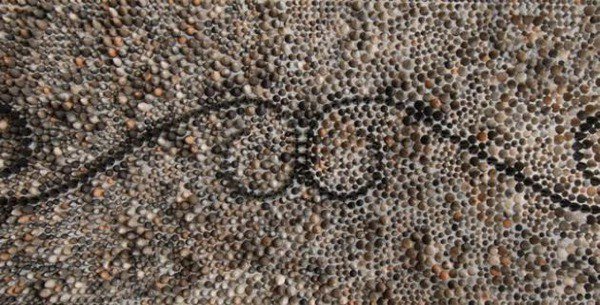Raksha Gobardan
dal 4/2/2013 al 2/3/2013
Segnalato da
4/2/2013
Raksha Gobardan
Kznsa Gallery, Durban
Passage is a construction of the artist's identity as a South African of Indian origin. The installation is the result of three years of experimentation with the use of mosaics and tiles as an aesthetic element.

I am a Hindu female of Indian origin, born in Estcourt, in the Kwa-Zulu Natal Midlands, where I experienced a mix of Indian, European and Zulu culture. I moved to Durban in 1998 to pursue my studies in Fine Art. At the onset of my Masters programme in Fine Art, I married into a Hindu home and in 2011 I gave birth to my first child. This brought with it responsibilities of family, being a wife and a mother. It is this journey that is explored in my work.
This installation is the result of three years of experimentation with the use of mosaics and tiles as an aesthetic element. This process began with the collection of old doors. The use of the door as an architectural element suggests the idea of entering or exiting evoking emotions and a sense of new beginnings, taking on the role of a wife and recently the role of a mother, all of which are highlighted in my work. Old doors were used because of the history that they embody. This was especially true of two doors which came from my grandmother’s house. The use of wooden doors in the construction process references the construction of my identity.
Each door embodies my experiences and manifests my identity as a female South African of Indian origin. The tile installation beneath each door creates a literal and symbolic entry point.
The work titled Goddess refers to a female deity. Here, the female goddess is associated with independence, motherhood, love, and the household. These attributes are associated with the different roles played in my daily life. The clay figures were sculpted using terracotta clay and imbedded in the recessed, rectangular areas within the door. Each recessed area is mosaicked using handcrafted earthenware tiles. Each tile was made using thin, rolled out sheets of clay that were embossed with Indian patterns and motifs, glazed and smoke-fired. The tiles were then cut and used as mosaic elements. The remaining clay elements on the door symbolise the lotus flower, a type of water lily that grows in murky waters. Hinduism believes that man is rooted in materialism, but with faith in the divine he can emerge pure and enlightened, just like the lotus flower (Lotus flower Online, 2012). These clay elements were made using terracotta clay, red iron oxide and gold lustre glaze. Surrounding the recessed areas of the door, I have used the amasumpa, as a border. They reference the Zulu presence in my identity.
The door titled Commercial Deity came from my grandmother’s house and eexplores the commercialisation of the Hindu religion and the negative impact that modernity and globalisation have had on religion and spirituality. Found calendar prints were used to create a collage in the recessed areas of the door. These old and faded prints contain images of religious icons that are mass produced and sold to the Hindu public. As a practicing Hindu, I am against such commercialisation. This artwork links my position to this global phenomenon.
Mass produced items like brass plates, ceramic casts of the deity Ganesha, and plastic idols of various deities were attached within this collage . The plastic deities were mounted on ceramic plates and glazed with under glazes and different colour lustres, in an attempt to provide each idol with a unique appearance; thus subverting their mass produced anonymity.
A variety of brass deities were attached to the edge of the door, mounted on rusty, metal disks that create a contrast. Self-adhesive bindis2 made of felt, or thin metal, form a continuous link around the door. The door is stained with bright colours associated with Indian culture.
A bindi, from Sanskrit bindu, meaning "a drop, small particle, dot", is a forehead decoration worn in South Asia (particularly India, Pakistan, Bangladesh, Nepal, Sri Lanka and Mauritius).[1] and Southeast Asia (Wikipedia, 2012).
The work titled Shaadi, explores the symbolism of my Hindu wedding. The title Shaadi is a Hindi term meaning wedding. The door in this work is covered with a sari, which is traditionally worn as a wedding dress by Indian women. The sari contains an embroidered image of a garland. In a Hindu wedding, the exchange of garlands is a gesture of acceptance of one another. Within the garland are embroidered portraits of myself and my husband and images of the mendhi design applied on my hand , on the night before the wedding. The Mendhi ceremony is an important ritual and usually takes place one or two days before the actual wedding. The colour of the mendhi is the traditional Hindu colour of auspiciousness, joy and celebration.
Prior to embarking on this journey, integrity and authenticity was absent in my work as a ceramicist and I found it difficult to express my identity in my work. This period of reflection has taught me to rely on my intuition and to trust the creative process in the production of a body of work through which I have explored my personal identity.
Opening 5 february 6pm
KZNSA - KwaZulu Natal Society of Arts
166 Bulwer Road, Glenwood, Durban



